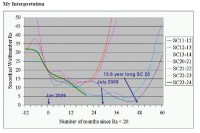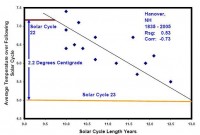By David Archibald
Jan Janssens of the Belgian Solar Section has kindly updated his graphs on the progression of the current minimum.

See larger image here.
Jan Janssens’ Comments: According to the spotless-day-method, the current cycle transit mimics much better the transit of the old cycles 10-15 than that of the more recent cycles 16-23. Thus, a minimum could be expected in July 2009 +/- 6 months. According to the old-new-groups-method, SC23 seems to change tracks as expected. It is heading for a better tracking of the old cycles rather than that of the more recent ones. SC24 continues to follow the very slow rise of the old cycles. Both evolutions indicate a break-even of the old/new groups at year’s turn, with a minimum in November 2008 +/- 6 months. No change from my initial prediction on 19 April 2008.

See larger image here.
This is a Jan Janssens graph that I have annotated. Solar Cycle 23-24 minimum is tracking along with Solar Cycles 11 to 14 from the 19th Century. A 13.6 year length for Solar Cycle 23, equivalent to Solar Cycle 4, is within the realms of possibility. The reason why we are interested in the month of solar minimum is because it is the first physical sign of the potential amplitude of Solar Cycle 24, which in turn has climate consequences. It is apparent that Solar Cycle 23 is a long one. I agree with Jan Janssens’ spotless day-derived result of month of minimum being July 2009. If Solar Cycle 24 is as weak as I think it will be, then it will have a slow ramp up - much slower than the late 19th century cycles used for comparison.
This leads to another point. Solar cycles generally have four years of rise and seven years of decline. Solar Cycle 5 (the first half of the Dalton Minimum) had 6.9 years of rise and 5.4 years of decline. If Solar Cycle 24 mimics Solar Cycle 4 in this way, then year of maximum will be 2016, four years after the latest estimate from NASA’s solar prediction panel. There is another interesting parallel with the late 18th century. Solar Cycle 3 was an ultra short one at 9.2 years, much the same as Solar Cycle 22 at 9.6 years.
Climatic Impact: Each day’s passing of anemic Solar Cycle 24 sunspot activity reinforces the imminent cooling.

See larger image here. See full pdf here.




